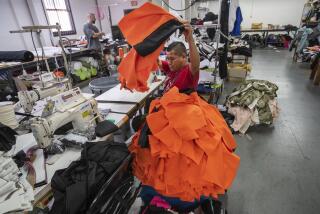New Orders to Factories Decline 0.9% : Analysts Cite Foreign Competition for 7th Drop in 10 Months
- Share via
WASHINGTON — Orders to U.S. factories dropped 0.9% in January, marking the seventh decline in the last 10 months, the government reported Tuesday.
Analysts ascribed much of the weak growth to stiff foreign competition luring work away from domestic manufacturers.
The Commerce Department report said orders fell $1.7 billion in January to $192.2 billion.
That followed a 0.1% decline last December and a 4.5% increase last November.
While orders for durable goods--those items expected to last three years or more--rose modestly, orders for non-durable goods dropped to their lowest level since October, 1983.
The 3.9% decline in non-durable goods--products such as paper, chemicals and food--left them at $88.3 billion.
Orders for durable goods rose 1.8% to $103.9 billion, but the increase was scaled back significantly from an advance report that showed that orders for durable goods rose 3.8% in January.
Robert Wescott, a senior economist at Wharton Econometrics, said the weak growth in orders to manufacturers was coming despite a rebound in economic activity during the final three months of last year.
He said the difference could be explained by the surge in imported goods.
Growth May Be Cut
“Orders that would be going to domestic manufacturers are going overseas instead,” he said.
Because of this trade hemorrhage, Wescott predicted that growth this year would be reduced by about 0.6% below what it otherwise would be.
Wharton is forecasting that the economy will grow 3.6% this year, down sharply from the 6.9% growth turned in during 1984.
Robert Ortner, chief economist for the Commerce Department, agreed that the nation’s trade imbalance was holding domestic growth back, but he said the Administration’s forecast of 4% growth in 1985 was still achievable.
Growth this year will be concentrated primarily in defense, high-technology companies, the service category and home building, Ortner predicted.
“The mix in the economy will continue to shift away from general manufacturing and toward these areas,” he said.
Both economists said businesses would keep inventory building to a minimum because low inflation rates and plentiful supplies provided no incentives to increase stockpiles.
The report said the increase in orders for durable goods came primarily from a 12.5% gain in orders for primary metals, such as steel, and a 13.6% increase in orders for electrical machinery.
Recouped December Loss
The category of defense equipment posted an 11.7% increase last month, which recouped most of the loss in December following a 110.4% November surge.
More to Read
Inside the business of entertainment
The Wide Shot brings you news, analysis and insights on everything from streaming wars to production — and what it all means for the future.
You may occasionally receive promotional content from the Los Angeles Times.










